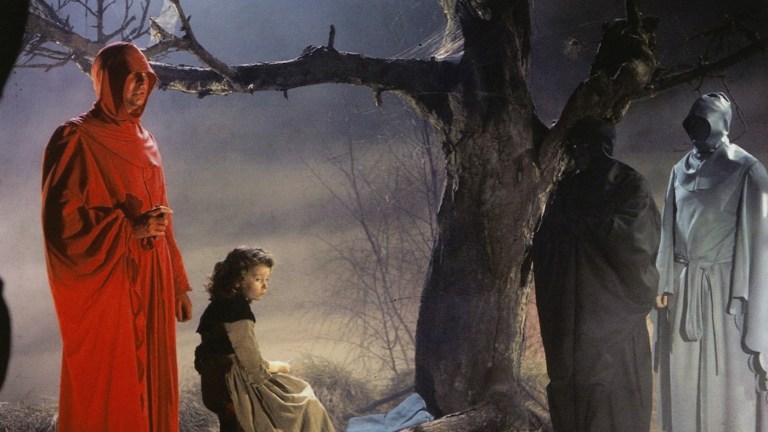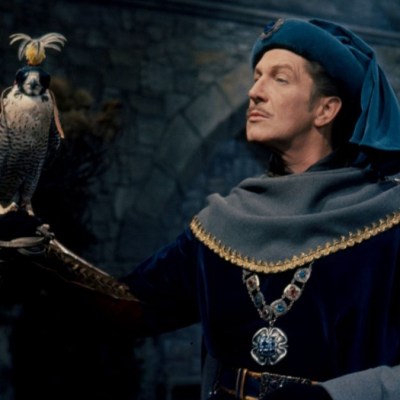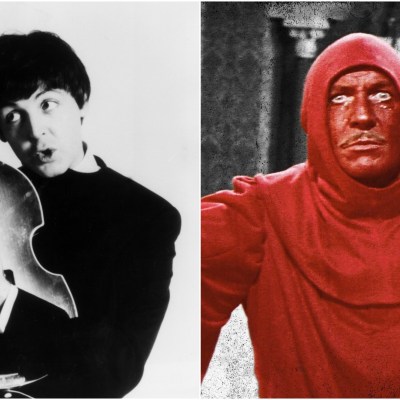How Roger Corman Finally Restored His Uncensored Vision for The Masque of the Red Death
Roger Corman's The Masque of the Red Death broke a satanic covenant and ushered in a diabolic cinema classic.

The Masque of the Red Death, Roger Corman’s masterful 1964 adaptation of Edgar Allan Poe’s short story, has been fully restored and can now be seen in all its diabolical splendor. The seventh of eight “Poe Cycle” films Corman made in the 1960s, Masque is arguably the best. Before its release, Poe had already delivered Corman from the low budget black and white films he shot in 10 days in the 1950s to the relative luxury of three-week shoots and psychedelic underworlds.
The new DVD/Blu-Ray is the first fully uncut, extended version of the film to be available. Besides restoring cinematographer Nicolas Roeg’s sumptuous camerawork, we get extra scenes which were cut by censors. The package also includes a 20-page booklet with a new essay from the Academy of Motion Picture Arts and Sciences’ film preservationist Tessa Idlewine.
The original “The Masque of the Red Death” short story was published in 1842, and it is only 15 paragraphs long, shorter than a Cracked article. To fill out the horror feature, screenwriters Charles Beaumont, who wrote episodes of The Twilight Zone as well as The Seven Faces of Dr. Lao, and science fiction author R. Wright Campbell incorporated Poe’s short story “Hop Frog” as a subplot, and added elements of the short story “Torture by Hope” by Auguste Villiers de l’Isle-Adam.
While Corman’s The Masque of the Red Death has discovered new life as a comforting modern parable during the COVID-19 pandemic, when it was released in 1964, many took the film to be a comment on the nuclear nightmares of the Cold War era. It did open the same year as Stanley Kubrick’s Dr. Strangelove. And atomic bomb fallout resulted in its own “Red Death,” leading to an entire generation to be assured the living would envy the dead. The film was filmed during the Profumo Scandal of 1963, and British tabloids were filled with stories of “Man In The Mask Parties” in Hyde Park Gate.
“I have Tasted the Beauties of Terror”
As an Anglo-American horror movie, The Masque of the Red Death continues European genre progressions set by the Italian Gothic film, Beatrice Cenci, directed by Riccardo Freda in 1956, and Mario Bava’s 1963 film La frusta e il corpo (The Whip and the Body). Corman’s influences went beyond genre, however, incorporating the post-apocalyptic imagery of Ingmar Bergman’s The Seventh Seal. In Masque, Death’s messengers report survival rates to their Master, who calculates only “a dwarf jester and five other people remain alive in the world.”
In an interview about the film’s restoration with Den of Geek, Corman admits he “should watch more genre films to keep up with it. But I’m more inclined towards somewhat more serious films, and particularly foreign films.”
The Masque of the Red Death also appears to owe a great debt to American experimental independent filmmaker Kenneth Anger’s Inauguration of The Pleasure Dome (1954), and recalls Michael Curtiz’s 1933 horror film, Mystery of the Wax Museum, which was shot in the pink-and-green two-color Technicolor process.
After years of black and white exploitation pictures for American International Pictures (AIP), Corman’s Poe cycle began his move to color, and the exciting new challenges of shooting beyond monochrome. The adaptation of The Masque of the Red Death set a new level of excellence in Corman’s use of set dressing, lighting, and costume design. They are given a fuller palette.
Says Corman, “I always thought that Poe represented the unconscious mind, and I shot according to that. It was one of my themes.”
In Poe’s story, the pride of Prince Prospero’s palace is seven rooms. Each is decorated and illuminated in a specific color: blue, purple, green, orange, white, and violet. The last room is black and bathed in light which shines a deep color of blood. All of the furniture is black, including a clock, which chimes each hour. At the chime of the clock, the revelers at the masquerade freeze. The musicians stop playing. The dancers strike a pose, and all conversations stop. Revelry resumes when the chiming stops. The rooms represent the human mind, the blood and time infuses corporeality. Corman’s direction manages to let that seep into every frame. The tone is both mischievous and chilling.
The Masque of the Red Death is atmospheric. The dialogue is more important than the action, but the settings and framing are paramount. “I felt the unconscious mind doesn’t really see the world,” Corman explains. “The conscious mind sees the world with eyes, ears, and so forth, and simply transmits information. So, I made a point on all of the Poe films of never going outside unless I absolutely had to. I wanted to have full control, to shoot within the studio. Whether it came through to the audience, I don’t know. But at least in my own mind, I was able to deal with special effects with a number of things, with the concept of the unconscious mind.”
The cinematography was done by Nicholas Roeg. While Corman hadn’t yet become acquainted with Mario Bava, Roeg’s camera allows the Italian horror director’s psychedelic influence to surge through the camera. The Masque of the Red Death “was the first I had done in England,” Corman tells us. “And they showed me a work of a number of English cameramen, and I thought Nic was the best of the group. And the collaboration went very well. I thought he did really, a brilliant job [with the] camera work.”
Roeg would go on to direct classic independent cinema with films like Don’t Look Now, Performance starring Mick Jagger, and the David Bowie cinematic encapsulation, The Man Who Fell to Earth. “I never knew, did I inspire him to be a director, or did he feel ‘if Roger can do it, anybody can do it?’” Corman wonders.
While Corman had a bigger budget and more time to make the film, cost- and labor-cutting alternatives occasionally provided fortunate outcomes. “Danny Heller, my art director, and I, always went to what was called a scene dock in studios where we’re going to work,” Corman says. “The scene dock contained flats from previous pictures, just individual flats. When we did Masque of the Red Death, we found these magnificent flats from Becket.”
The Price of Evil
Vincent Price has the most delicious delivery in this film. His devil worshipping Prince Prospero is the cruel sovereign of a village plagued with an all-consuming Red Death, and Price’s inflections are infectious. His voice is seductive, and his cruelty brims with good humor.
“He had the character pretty much set in mind when he came into it,” Corman remembers. “Vincent always did a great deal of preparation. We would discuss the characters, just Vincent and me, before the rehearsals. He and I were in agreement on the character, and then he would bring that character to the rehearsals. We did not do a great deal of rehearsing because of the Screen Actors Guild rules. They charge you as if you are shooting when you rehearse.”
Price played Roderick Usher in Corman’s first Poe adaptation, The Fall of the House of Usher. For The Masque of The Red Death, the director only gave one note. “As I remember, I said, ‘The really key to Prospero’s character is that he believes God is dead,’” Corman says. “And everything stems from that belief. That with the absence of God, he was free to do anything he wanted.”
Ultimate power breeds ultimate corruption. The film is set in a country decimated by an epidemic. While the prince of this unnamed land offers refuge for his courtiers, he derives perverse satisfaction in condemning his subjects to death by their exclusion. While Prospero is making his annual deign-to-see-the-peasants day, one of the townspeople dies of Red Death.
The prince intended to offer peasants some crumbs in appreciation of their labor, but young Gino (David Weston) mocks him. To make matters worse, the ungrateful worker’s lover Francesca (Jane Asher) defends the man, prompting Prospero to label both of them insurrectionists. He burns the village to the ground, throws Gino and Francesca’s father into one of the most foreboding castle dungeons in horror history, and puts Francesca up at his palace. Tempted by the idealism and faith of the village’s “resistance,” Prospero corrupts and sacrifices for sheer joy.
Meanwhile the prince promises his aristocratic guests that they will be immune to the scourge, unless they displease him. He throws a masked ball and forbids anyone to wear red, as it would be in bad taste. He is actually preparing a mass sacrifice in exchange for Satan’s favor. Asher’s Francesca is an incorruptible innocent who seems to have perfect faith. The Satanic prince will not tolerate any Christian worship on his estate, so he delights in tempting the faithful into the “velvet darkness” of evil. Prospero hopes to turn her into a Satanist or drive her mad.
For the Uninvited, There is Much to Fear
The film was hit with heavy censorship. In the U.S, the Catholic Legion of Decency sent a list of changes, and in the UK, the British Board of Film Censors required a separate set of cuts. The Legion of Decency bemoaned the “Satanism and erotic costuming” on the screen, according to the booklet which comes with the DVD/Blu-Ray package. Father Sal Miraliotta, a separate reviewer from the Legion of Decency, first approved the film and then changed his grade to a B, which meant morally objectionable. He ultimately downgraded it to a full Condemned rating, blasting the Satanic worship and its malignancy of the soul, and mocking the screenwriters’ “strung-together gibberish” and “mumbo-jumbo Latin.”
Hazel Court’s Juliana is captivating and as conniving as Prince Prospero. She’s also more subtly insidious. Juliana dedicates herself to the service of Satan and receives the ultimate payoff. While most of Juliana’s satanic invocation was left in, censors wanted the word “Alleluia” removed. The U.S. version also censored the film’s climax. When the Man in Red is talking with Prince Prospero, the dialogue was changed from “Each man creates his own God for himself. His own Heaven – his own Hell” to “Each man creates his own Heaven – his own Hell.” This takes out the idea that God could be created by man, something Ian Anderson would explore on Jethro Tull’s classic 1971 album, Aqualung.
When asked whether all this divine intervention made Corman think he just might be going to hell, he says, “No, that never occurred to me. I’m sort of a lapsed Catholic, and I don’t believe there is a hell.”
Some of the cuts had nothing to do with blasphemous ideology. The tiny dancer Esmeralda is played on camera by young actor Verina Greenlaw, but her dialogue was dubbed over by an adult woman. Skip Martin’s clever Hop Toad character plots vengeance over her royal mistreatment at the hands of Alfredo, campily played by veteran actor Patrick Magee. One unsettling scene was removed from the U.S. version because it seemed Esmerelda’s relationship with Hop Toad was more than friendship.
Corman also cut nine frames from the scene where Francesca is stripped down and thrown into a bathtub because it gave the illusion of nudity. The removed frames ensured Asher’s breasts would not appear on screen.
“I’ve Already Had That Doubtful Pleasure“
The irony, upon seeing the restored scenes, is how they actually feed into the surprisingly righteous conclusion of the film. The Masque of the Red Death is rife with blasted, unholy incantations, but the prince’s callous sacrifices and lifelong debauchery mean nothing to a master who answers to no one. Talk about moral relativity! The hero of The Masque of Red Death is Death, and Death worships no gods and no devils. The depths of Prospero’s belief turn out to be mere demonic delusions.
Corman shot the low-budget Poe pictures through bulky Mitchell cameras on 35mm film and the restoration breathes a new life to each underfunded frame. Composer David Lee’s soundtrack of tambourines, fifes, and brass evokes the medieval period, as do the elegant costumes by Laura Nightingale. The restoration highlights the lushness of both, as they mix to underscore the “velvet darkness” with subliminal subtext of renewal and hope. At the same time, the restored cut actually makes the darkness darker.
The Masque of Red Death ends with the words “Sic transit gloria mundi,” Latin for “thus goes the glory of the world.” Corman’s take on Poe’s apocalyptic parable is a truly inglorious achievement. The film is proof that no budgetary restrictions hold back artistic vision when lunatics get the run of the asylum. They can create and destroy a whole crazy world.
The Masque of the Red Death is available on Blu-Ray, DVD, and Digital now.


